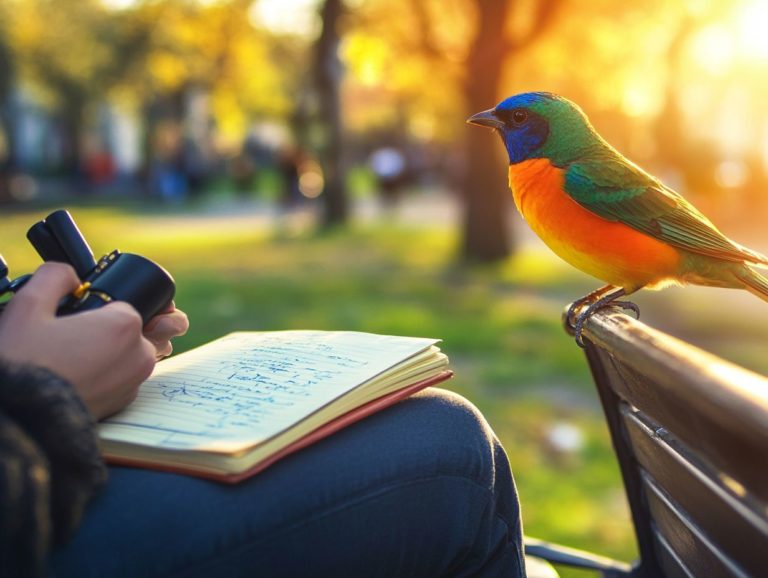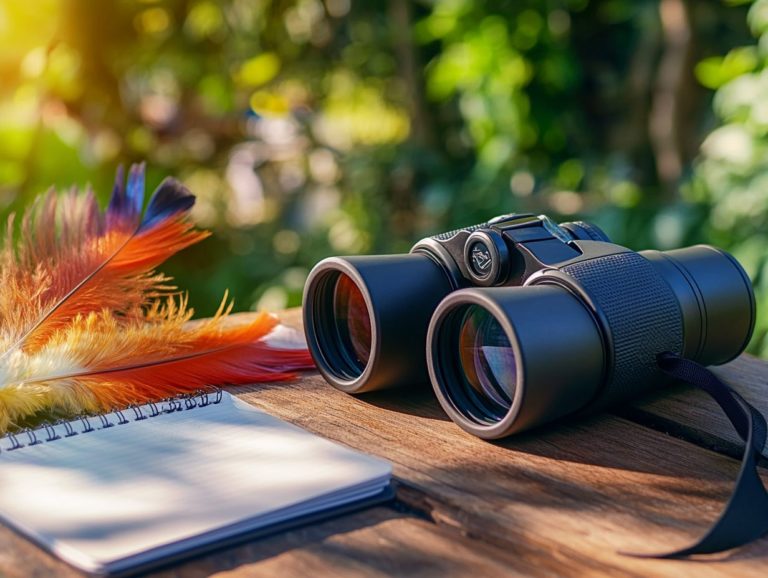Why Is It Important to Choose the Right Bird Watching Gear?
This birdwatching guide covers the essentials, including an overview of birdwatching, tips for selecting binoculars and other essential gear, the advantages of investing in high-quality equipment, and advice on maintaining your gear to ensure a rewarding birding experience every time you venture outdoors.
Contents
- Key Takeaways:
- The Basics of Bird Watching
- Choosing the Right Binoculars
- Factors to Consider
- Other Important Gear for Bird Watching
- Benefits of Investing in Quality Gear
- Tips for Maintaining and Caring for Your Gear
- Frequently Asked Questions
- What should I consider when choosing a pair of binoculars for bird watching?
- Why is a field guide necessary for bird watching?
- How does proper clothing and footwear affect bird watching?
- Why should we consider the well-being of birds when choosing bird watching gear?
Key Takeaways:
- Investing in quality gear for birdwatching leads to an improved viewing experience and longer-lasting equipment.
- Proper maintenance and care, such as cleaning and storage, can help protect your gear and ensure its longevity.
- When choosing birdwatching gear, consider factors such as magnification, lens quality, and durability to get the most out of your experience.
The Basics of Bird Watching
Bird watching is an enjoyable activity for both hobbyists and professional birders, involving the observation of birds in their natural habitats. Enthusiasts often use various optical tools, like binoculars or telescopes, to enhance their experience.
This pursuit not only fosters a deeper understanding and appreciation of avian life but also offers insights into bird behavior and conservation practices. Bird watching is a rewarding pastime for individuals of all ages.
What is Bird Watching?
Bird watching involves observing birds in their natural habitats and using field guides to identify different species. This exciting hobby helps you connect with nature in a meaningful way.
Many birders enhance their experience by using binoculars or telescopes, which enable closer observation without disturbing the birds. Effective observational methods, such as listening for distinctive calls and watching behaviors during feeding or mating, are crucial for successful identification.
Documenting findings in a life list or journal helps bird watchers gain insights into bird behavior and migratory patterns, thereby deepening their appreciation of the ecological roles that birds play in our environment.
Essential Gear for Bird Watching
Essential gear is crucial for enjoying birdwatching, with binoculars being the most important tool. They enhance viewing through higher magnification and offer portable convenience.
Choosing the right binoculars depends on various factors, including size, weight, and lens features. All of these factors significantly affect comfort and clarity during long observation sessions.
Field notebooks are also vital, as they allow enthusiasts to document their observations and sketches. This fosters further learning about avian behavior. Field guides provide valuable insights into different species, aiding in the real-time identification of birds.
These tools collectively create a more immersive experience, enabling each observer to connect with nature more personally by capturing fleeting moments that might otherwise go unnoticed.
Choosing the Right Binoculars
Selecting the appropriate binoculars for birdwatching is essential for an optimal viewing experience. The right configuration and optical quality can significantly enhance bird identification and observation.
There are different types of binoculars, including roof and Porro prism designs. Understanding the specifications of binoculars is crucial for making informed decisions when shopping for them.
Don’t miss out on the chance to witness nature’s wonders! Equip yourself with the right tools and start your birdwatching adventure today.
Factors to Consider
When choosing binoculars, several important factors come into play. These include magnification, weight, and type. Each of these elements can significantly enhance your birdwatching experience.
The most crucial factor is binocular magnification. This is indicated by the first number in the binocular’s configuration, such as 8×42 or 10×42. The first number represents the magnification strength, while the second number indicates the size of the objective lens in millimeters. Magnification refers to how much closer an object appears through binoculars compared to the naked eye.
Generally, higher magnification binoculars offer greater zoom. However, they also have a narrower field of view, making it challenging to follow moving objects. Higher magnification can also make it hard to keep the view steady. For birdwatching, the best binoculars typically feature magnifications ranging from 7x to 12x.
The quality of the optics is another important factor that affects your viewing experience. This includes the type and quality of lens coatings, which enhance light transmission and durability. It also involves the prism, the part that helps in gathering light, which can improve clarity and reduce distortions. The internal mechanisms of the binoculars also matter.
A helpful feature for birdwatchers is the close focus range, the minimum distance at which the binoculars can clearly focus on an object. Since birds often fly close to the ground, binoculars with a low close focus range—like 5 feet—can be extremely beneficial.
Weight is another critical factor, especially for those who may spend hours outdoors. Heavier binoculars can cause hand strain and fatigue, while lighter binoculars make it easier to observe and carry, which is essential for those who walk long distances in pursuit of their favorite birds.
The type of binoculars also affects their weight. The most common designs for birdwatching are porro prism and roof prism binoculars. Porro prism designs tend to be heavier and bulkier but allow for larger objective lenses. In contrast, roof prism designs are more compact, making them easier to transport, and are generally available with higher magnifications than their porro prism counterparts. Birdwatchers should experiment with both types to find which design offers the best comfort and usability.
Other Important Gear for Bird Watching
Spotting scopes, field guides, digital recorders, and laser pointers are essential tools that enhance the overall birdwatching experience when used alongside binoculars.
Spotting Scope
A spotting scope is an essential birding optic for those seeking high magnification and close-up views of distant birds. This specialized tool enables enthusiasts to observe fine details of plumage and behavior that are difficult to see with binoculars.
High-magnification scopes can reach up to 60x or more, providing an exceptional level of detail when observing wildlife in its natural habitat. A spotting scope complements binoculars perfectly, especially for individuals who prefer long-distance viewing.
When selecting a scope, features like light-gathering power—which increases visibility in lower light— and portability are crucial for those who frequently travel across various terrains.
Field Guide
A field guide is an essential resource for bird watchers, providing information needed to identify various species and learn about their behaviors. These guides serve not only as reference tools but also offer valuable insights into bird habitats, enriching the overall birding experience.
Resources like Peterson’s Field Guide to Birds and the National Geographic Field Guide to the Birds of North America help bird watchers develop skills for recognizing the unique characteristics of different species. Many field guides also include information about conservation initiatives, educating users on the importance of preserving certain bird species and their habitats.
This awareness fosters a sense of stewardship for the environment and the birds that inhabit it.
Benefits of Investing in Quality Gear
Investing in quality gear for bird watching offers several benefits. It provides an enhanced viewing experience and improves the durability and longevity of the equipment. This means bird watchers can enjoy their passion for many years!
Improved Viewing Experience
Investing in high-quality optics and binocular features designed for bird watching significantly enhances the viewing experience. When enthusiasts select equipment with better image quality, they notice remarkable improvements in clarity, brightness, and color accuracy.
These features provide sharper details of plumage and vibrant colors, making it easier to identify various species in their natural habitat. Essential aspects like waterproofing ensure unpredictable weather doesn’t hinder an adventure. An ergonomic design, which feels comfortable to hold and use, promotes comfort during extended observation periods, making each expedition enjoyable and rewarding.
Durability and Longevity
Durability and longevity are essential qualities in quality birdwatching gear. They ensure that the equipment functions effectively under various field conditions. Choosing the right materials for optics, tripods, and other accessories is crucial.
Birding binoculars made from robust materials can withstand outdoor use, including falls and harsh weather. This durability is particularly important for serious enthusiasts who may spend extended periods in the field away from home.
Proper maintenance routines can significantly extend the lifespan of this equipment. Regular cleaning and careful storage of binoculars and spotting scopes, along with properly folding or collapsing tripods, are simple yet effective steps that birdwatchers can take to enjoy the benefits of durable construction long after their initial purchase.
Tips for Maintaining and Caring for Your Gear
Proper maintenance and care ensure optimal binocular performance and extend the longevity of bird-watching equipment.
Proper Cleaning and Storage
Proper cleaning and storage of birdwatching gear, especially binoculars, are essential for maintaining optimal performance and longevity. Use appropriate materials designed for lens care, such as microfiber cloths and specialized lens cleaning solutions that won’t damage the coatings.
Avoid household cleaners, as they can leave residues or scratch the glass. Using cases with moisture-wicking features protects the gear from humidity and prevents mold growth.
For storage, choose a controlled environment that avoids areas with extreme temperature fluctuations. These fluctuations can affect the integrity of both the binoculars and their cases over time.
Protecting Your Gear in the Field
Protecting gear in the field is essential for maintaining longevity and functionality, especially in harsh outdoor environments. Using protective strategies keeps binoculars and other equipment functional.
Utilizing protective cases with effective shock absorption features can safeguard gear against knocks and drops. Padded straps add comfort during extended use and help keep the gear secure.
Additionally, using equipment made from weather-resistant materials protects against rain and high humidity, allowing for worry-free exploration. Being mindful of environmental factors, such as dust and extreme temperatures, further preserves the gear’s functionality, ensuring that bird watchers can fully enjoy their time outdoors.
Frequently Asked Questions
Why is it important to choose the right bird watching gear, and what are some examples?
Choosing the right bird watching gear greatly enhances your birding experience and helps you spot more birds. Essential gear includes a pair of binoculars, a field guide, a notepad and pen, and appropriate clothing and footwear.
Start caring for your gear today to ensure you never miss a moment in the wild!
What should I consider when choosing a pair of binoculars for bird watching?
When choosing binoculars, think about how close things appear and how much you can see at once. Try them out before buying to ensure they fit your needs.
Why is a field guide necessary for bird watching?
A field guide lets you identify different bird species easily. It also shares insights on bird behavior and where they live.
How does proper clothing and footwear affect bird watching?
Wearing the right clothes and shoes can turn your birding adventure into a fun and safe experience! Choose clothes that help you blend in and sturdy shoes for different terrains.
Why should we consider the well-being of birds when choosing bird watching gear?
The right gear helps us observe birds from a distance without disturbing them. This care is crucial for their well-being and helps with conservation efforts.






